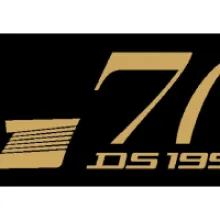SHERIDAN, WYOMING – Jan. 24, 2025 – DS Automobiles, a brand synonymous with French luxury and avant-garde design, boasts a rich heritage that began with the revolutionary DS model in 1955. More than just a car, the DS redefined automotive standards and became a global icon of innovation, elegance, and technological advancement.
Fathers of the DS
The DS was the culmination of a 17-year project spearheaded by Citroën executives Pierre Boulanger and Pierre Bercot. Three visionary men were instrumental in bringing this groundbreaking vehicle to life:
- André Lefèbvre: An aeronautical engineer who championed front-wheel drive, aerodynamics, lightweight design, and centralized mass.
- Paul Magès: A self-taught engineer who revolutionized automotive technology with the invention of the hydropneumatic suspension and hydraulic systems for steering, clutch, and braking.
- Flaminio Bertoni: A gifted stylist, sculptor, and painter who, along with his team, crafted the DS's revolutionary and elegant design.
1955 Motor Show: The DS Makes its Debut in Paris
The DS 19 made its grand entrance at the Paris Motor Show on October 6, 1955. Its avant-garde design and innovative technology captivated visitors and journalists alike. The response was overwhelming, with thousands of orders placed within days of its unveiling.
The 1950s: DS Takes Off!
Production of the DS commenced immediately following its successful debut. The car's distinctive design and advanced technology, including its remarkable hydropneumatic suspension and powerful hydraulic braking system, drew crowds wherever it went.
Throughout the 1950s, several versions of the DS 19 were introduced, including the ID 19, estate, family, and commercial models, as well as the luxurious DS 19 Prestige. The DS 19 also expanded its color palette, offering an unprecedented choice of eight bodywork paints.
The DS 19 quickly gained international recognition, with assembly plants established in the UK, Belgium, and South Africa. It was exported worldwide, becoming a symbol of French elegance and innovation.
DS Prestige: Chauffeur Driven
In 1958, DS introduced the DS 19 Prestige, a chauffeur-driven version designed for political and industrial leaders. Featuring exclusive black body paint, a retractable glass partition, and luxurious leather and Jersey fabric upholstery, the DS 19 Prestige offered exceptional comfort and sophistication.
Wins in Monte Carlo: A Formidable Competition Car
The DS 19 proved its performance capabilities on the rally circuit, securing a class victory in the prestigious Monte Carlo Rally just three months after its launch. In 1959, the ID 19 achieved an overall victory in the same rally, solidifying the DS's reputation as a formidable competitor.
The 1960s: DS Leads the Pack
The DS continued to evolve throughout the 1960s, with enhancements to its engine, design, and features. Notable introductions included the DS 19 Cabriolet, a facelift featuring improved aerodynamics, and the powerful DS 21 with a 2,175 cc engine.
In 1967, the DS received another facelift, incorporating swivelling headlamps for enhanced safety and visibility. Further engine upgrades in 1969, including electronic fuel injection for the DS 21, cemented its position as a leader in automotive innovation.
DS Cabriolet: Four Seats in the Open Air
The DS Cabriolet, launched in 1960, was a collaboration with coachbuilder Henri Chapron. This elegant convertible, with its meticulous finish and luxurious features, remains a benchmark in French automotive design.
DS Pallas: Luxury and Excellence
Introduced in 1964, the DS Pallas offered unparalleled luxury and refinement. With its distinctive styling, plush interiors, and exclusive features like metallic paint, the DS Pallas set a new standard for French production cars.
DS Presidential: The Longest of its Time
In 1968, a unique, extended DS limousine was commissioned for the French president. Built by Henri Chapron, this 6.53-meter long vehicle featured ultra-luxurious amenities, including a retractable glass partition, leather upholstery, air conditioning, and a built-in minibar.
A Million DS Built!
The millionth DS rolled off the production line in 1969, marking a significant milestone for this iconic vehicle.
The 1970s: The Age of Maturity
The DS continued to evolve in the 1970s with upgrades to its transmission, including a five-speed manual gearbox and an optional automatic transmission. In 1972, the DS 21 was replaced by the DS 23, featuring a more powerful engine and a top speed of nearly 190 km/h.
The Last One…
After a remarkable 20-year production run, the final DS was produced in 1975. This DS 23 Pallas Electronic Injection in Delta Blue marked the end of an era.
DS as Cinema Star
The DS's iconic status extended beyond the automotive world, with prominent appearances in numerous films. From "The Parisian" with Brigitte Bardot to "Back to the Future 2" as a futuristic taxi, the DS symbolized elegance, speed, and innovation on the silver screen.
DS: Automotive Monument and Sculpture
The DS was recognized as a work of art from its inception. Its sculptural design was praised by philosophers and artists, and it was even exhibited as a standalone sculpture at the Milan Triennal and the Paris Motor Show.
DS: Ad Star!
The DS inspired innovative and memorable advertising campaigns. One iconic image, featuring a DS body suspended on balloons over water, became a symbol of the car's hydropneumatic suspension and a celebrated example of automotive advertising.
2014: Launch of the DS Automobiles Brand
In 2014, DS Automobiles was established as a standalone brand, carrying forward the legacy of innovation and distinctive design embodied by the original DS. Today, DS Automobiles offers a global range of vehicles that combine charismatic design, advanced technology, and exceptional comfort.
2025, DS N°8: An Invitation to the Electric Journey
The DS N°8, the brand's first 100% electric vehicle, represents a new era of sustainable luxury mobility. With its aerodynamic design, extended range, and advanced technology, the DS N°8 embodies the brand's commitment to innovation and the French art of travel.
